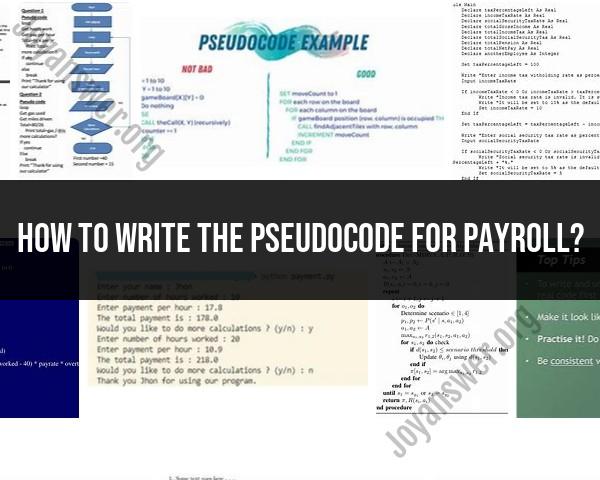How to write the pseudocode for payroll?
Writing pseudocode for a payroll system involves breaking down the payroll process into a series of logical steps using plain language, without worrying about the specific syntax of a programming language. Pseudocode serves as a blueprint for developing actual code. Here's a simple guide to help you write pseudocode for a basic payroll system:
plaintextSTART
Initialize variables:
totalSalary = 0
numEmployees = 0
Prompt for the number of employees
Input numEmployees
FOR each employee in range 1 to numEmployees:
Prompt for employee name
Input employeeName
Prompt for hours worked
Input hoursWorked
Prompt for hourly wage
Input hourlyWage
Calculate employee's gross pay:
grossPay = hoursWorked * hourlyWage
Display employee's name and gross pay
Print "Employee:", employeeName
Print "Gross Pay:", grossPay
Add grossPay to totalSalary
END FOR
Calculate total payroll expenses:
payrollExpenses = totalSalary
Display total payroll expenses
Print "Total Payroll Expenses:", payrollExpenses
END
In this pseudocode, we begin by initializing variables to keep track of the total salary and the number of employees. Then, we prompt for the number of employees.
Inside a loop (FOR loop), we repeat the following steps for each employee:
- Prompt for the employee's name.
- Prompt for the hours worked.
- Prompt for the hourly wage.
- Calculate the employee's gross pay by multiplying hours worked by the hourly wage.
- Display the employee's name and gross pay.
- Add the gross pay to the totalSalary variable.
After processing all employees, we calculate the total payroll expenses by summing up the gross pay of all employees. Finally, we display the total payroll expenses.
This pseudocode represents a simplified payroll system. In a real-world application, you would use a specific programming language to implement the logic, store data, and generate paychecks or reports. Additionally, you might need to consider tax calculations, deductions, and other complexities that are typically involved in payroll systems.
Pseudocode is a plain English description of the steps in an algorithm. It does not require any specific syntax or programming language knowledge, making it an accessible way to outline the logic of a program.
Writing Pseudocode for Payroll: Simplified Steps
To write pseudocode for payroll calculations, follow these simplified steps:
Define variables: Identify the variables needed to store employee information, such as hourly rate, hours worked, and deductions.
Input employee data: Gather employee data, including hourly rate, hours worked, and any applicable deductions.
Calculate gross pay: Multiply hourly rate by hours worked to determine gross pay.
Apply deductions: Subtract applicable deductions from gross pay to determine net pay.
Output payroll information: Display employee's net pay and any additional payroll details.
Pseudocode Example for Payroll Calculation
Here's an example of pseudocode for calculating an employee's net pay:
// Define variables
hourlyRate = input("Enter hourly rate: ")
hoursWorked = input("Enter hours worked: ")
deductions = input("Enter total deductions: ")
// Calculate gross pay
grossPay = hourlyRate * hoursWorked
// Calculate net pay
netPay = grossPay - deductions
// Output payroll information
print("Employee net pay:", netPay)
Translating Payroll Processes into Pseudocode
To translate payroll processes into pseudocode, break down each process into smaller steps and describe them in plain English. For example, calculating overtime pay might involve checking if hours worked exceed a threshold and applying an overtime rate.
Pseudocode for Payroll Automation
Pseudocode can be used to outline the logic for automating payroll processes. This might involve reading employee data from a file or database, performing calculations, and generating payroll reports.
Mastering Pseudocode for Payroll System Design
Mastering pseudocode for payroll system design involves understanding the overall payroll process, identifying key components, and translating them into clear and concise pseudocode. This helps in designing a well-structured and efficient payroll system.













